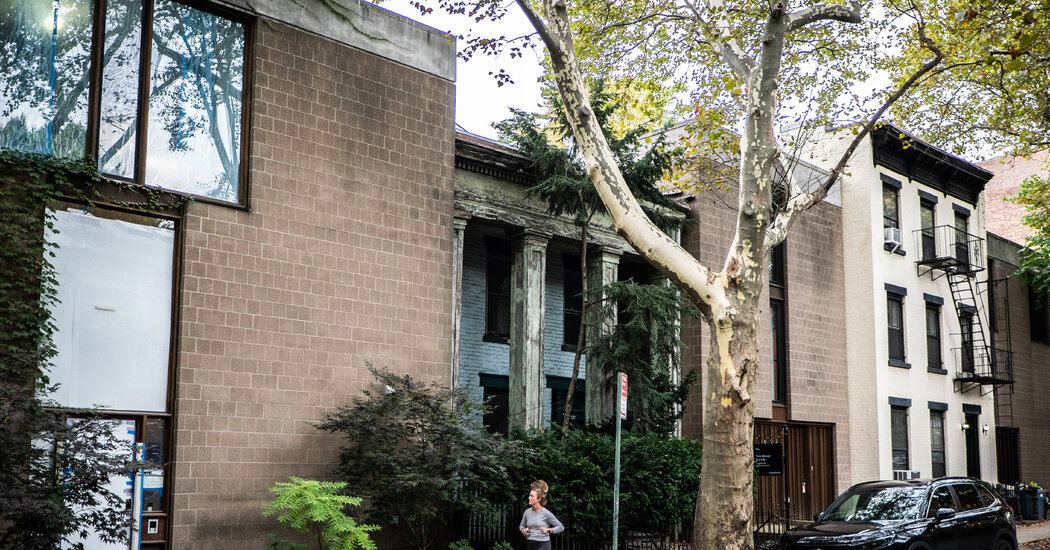One guidebook to New York City describes the house in Brooklyn Heights as follows: “Across the street is lovely #46, looking for all the world like a set from ‘Gone with the Wind.’”
The Greek Revival home in question, which appears as if it’s on the verge of collapse — its columns cloaked in peeling green paint — is wedged between two, hulking modernist townhouses and is the lone holdout of what was once a set of four colonnaded homes facing a parallel row across the street.
It was built in the 1840s, when there were still outhouses because homes did not have indoor plumbing, before the telephone and the electric bulb were invented and decades before construction began on the Brooklyn Bridge. Nearly two centuries later, the house was put up for sale this month by Brian Palmer and his sister, whose mother had lived there until shortly before her death last year at age 98.
Priced at just over $3.4 million, 46 Willow Place is listed for less than a third of what the house immediately to its left fetched in 2024 — $10.6 million. Its lower price reflects the rowhouse’s need for a complete overhaul. Inside, the linoleum is warped and bumpy, some of the light fixtures still have cloth wiring and the oven hasn’t been changed since the 1960s.
“My sister and I grew up there, hiding behind the pillars of the twin-story porch as guides stopped out front and told groups of tourists that the house was haunted,” Mr. Palmer, 61, wrote in an email. “Other passers-by would tell us that ours was their favorite house in the city and that we should never refurbish it to look like the flawless quartet of houses across the street.”
Mr. Palmer’s parents — Bob and Ina Palmer, a psychologist and New York City tour guide — bought the rowhouse for $50,000 in 1969, about $450,000 adjusted for inflation. Back then, songs in Spanish wafted over the backyard from the largely Puerto Rican neighborhood nearby, said Mr. Palmer, who was 4 when he moved in, alongside his sister Cynthia, then 3.
At the time of purchase, the green pillars of the house were already chipping and would never be repainted. The columns that both tourists and famous photographers stopped to capture are rare in Brooklyn now, but they were all the rage in the 1840s when the building was built.
The popularity of the style, borrowed from Athens, can be traced to a book published in 1762 by two British architects who traveled to Greece and took careful measurements of temples, reproducing the exact proportions in plates. Their work, “The Antiquities of Athens,” made its way across the Atlantic, where it served as a blueprint for pattern books. By the 1800s, Greek Revival had swept across the United States.
For a country that was then only a few decades old and emerging from war with the British monarchy, adopting the style of ancient Greece — the birthplace of democracy — was a way to assert the nation’s new identity.
“People who built houses, churches and civic buildings based on Greek temple forms expressed their belief that America was becoming a great civilization, one that would rival the glories of the ancient past,” according to the Metropolitan Museum of Art’s description of the style.
Churches, banks and government buildings were built in this style, including the Ohio and Vermont Statehouses, the North Carolina State Capitol and the U.S. Patent Office in Washington, whose architect reportedly bragged that the building’s proportions were “exactly those of the Parthenon in Athens.”
The craze began in the 1820s and continued into the 1850s. Smack in the middle of this period is when the house at No. 46 Willow was built.
Its exact origin is blurry. One book claims it was built in 1846. The listing by Compass says 1849. The architect is also unknown, although the biography of Anson Blake — an early developer of southern Brooklyn who made his fortune selling straw hats at a markup before becoming a real estate speculator — describes how he owned the colonnaded homes in the 1850s.
What’s clear is that the home was built not as a one-off but as a set: four colonnaded homes on the east side of the street facing a mirror image to the west. The row facing No. 46 remains intact and is memorialized in one of Berenice Abbott’s photographs, now held by the Met.
But today, No. 46 is the only one of its group left on the opposite side.
Though it was built in a grand style, No. 46 was always a modest example of that grandeur. Its columns are made of wood, not marble — more aspiration than affluence.
After they bought the house, the Palmers discovered that the old porcelain sink had cracks in it, filled with glue. One of the few changes the family made was replacing the broken sink with a stainless steel one from Sears.
At Stuyvesant High School, Mr. Palmer began an environmental magazine, which his sister took over two years later. It grew, with some issues spanning 76 pages. “So instead of fixing up the house, we had 16 kids sleeping over for layout weekend,” he said.
They were busy with their lives, but in the background hovered a frugality imposed by the stories their family carried into No. 46: One grandfather, scarred by wartime scarcity, insisted on washing sandwich wrappers and hanging them to dry on a clotheslines so they could be reused. Their mother, the daughter of a Jewish intellectual from Czechoslovakia, showed them how to make flowers out of tissue paper — it’s what her family did to eke out a living in New York after escaping the Holocaust.
When Mr. Palmer hid behind the pillars and listened to tour guides describing his family home, a mix of conflicting emotions washed over him: “We felt its uniqueness but we also felt a bit ashamed that it was not up to the standards of rest of the street,” he said.
Still, the tour groups kept coming, drawn by the same magnetism that kept the house and its columns standing.
“The oddity of this one is it’s story — it’s the surviving one,” said Patrick Ciccone, a co-author of a book about New York rowhouses and brownstones that includes a section on the colonnaded row.
“It’s like one tooth out of a smile.”
Rukmini Callimachi is a reporter covering real estate and housing for The Times.
The post A Fixer Upper That Predates the Brooklyn Bridge appeared first on New York Times.




